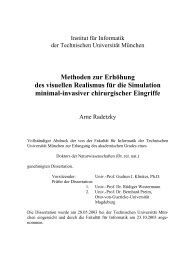Topologically Defined Neuronal Networks Controlled by Silicon Chips
Topologically Defined Neuronal Networks Controlled by Silicon Chips
Topologically Defined Neuronal Networks Controlled by Silicon Chips
You also want an ePaper? Increase the reach of your titles
YUMPU automatically turns print PDFs into web optimized ePapers that Google loves.
CHAPTER 1. INTRODUCTION<br />
Figure 1.1: Left: Piece of the human visual cortex with highly branched neurites and complex synaptic<br />
connection pattern, from [20]. Right: Schematic drawing of a simple, designed feed-forward network.<br />
Studying these systems, once they are established, requires long term control of network activity<br />
at the single cell level; action potentials must be evoked in and recorded from individual neurons.<br />
Standard electrophysiology, using impaled microelectrodes or patch clamp, is inappropriate because it<br />
harms the nerve cells, there<strong>by</strong> limiting the recording time to a few hours before cells die. Furthermore,<br />
spatial constraints with micromanipulators used for positioning the pipettes considerably restrict the<br />
number of cells that can be monitored. Alternative techniques are needed that are non-invasive, as<br />
sketched in fig. 1.2, and also can be scaled up to large neuronal assemblies .<br />
Figure 1.2: Invasive (left) and non-invasive (right) recording and stimulation of individual neurons.<br />
The aim of this thesis is to implement and study small networks of living neurons with a defined<br />
synaptic connection pattern. This requires advances in network design and extracellular recording,<br />
and lays the foundations for systematic tests of fundamental concepts in neuroscience.<br />
1.2 <strong>Defined</strong> networks and extracellular recording, state-of-the-art<br />
Since the ideas outlined above are not new, much work has already been done on network design and<br />
non-invasive recording. This paragraph gives a short overview of relevant technologies reported in the<br />
literature.<br />
A variety of methods exists for building topologically defined networks. Most of them use patterns<br />
of substrate-bound molecules that either promote or inhibit neurite outgrowth, e.g. silanes [56],<br />
poly-L-lysine [8] or proteins [81]. Neurons cultured on these substrates grow neurites that follow the<br />
permissive tracks while avoiding inhibitory areas. The patterns are made with techniques adapted from<br />
semiconductor processing, like photolithography [56], laser ablation [15] or microcontact printing [97].<br />
Although they guide advancing neurites rather well, somata and already grown neurites are frequently<br />
2
















